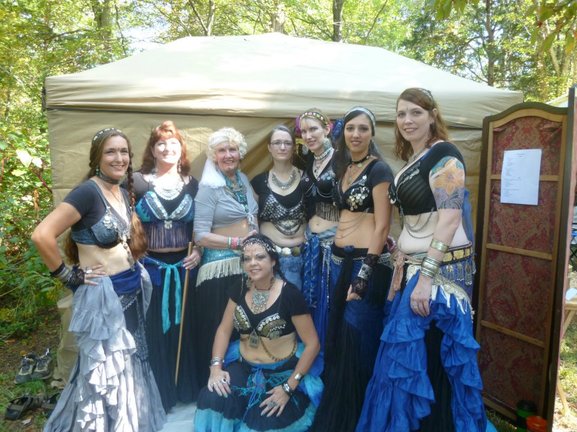Lynchburg Tribal: Bellydance in the 'Burg
Bellydance Classes, Workshops, Performances and More!!

Lynchburg Tribal is an organization for women, dancers, musicians, and artists committed to supporting the Belly dance and Middle Eastern Musical arts community of Lynchburg and Central Virginia by supporting and hosting events and Bellydance-related organizations.
We honor all styles of belly dance and welcome anyone who wants to become part of this growing and ever-evolving community.
We honor all styles of belly dance and welcome anyone who wants to become part of this growing and ever-evolving community.
What is Belly Dance?
Belly Dance is a dance form based on the traditional dances of the Middle East, North Africa, and parts of Asia. It is a modern form of dance with ancient roots that inspires the imagination and empowers the female consciousness.
A Bit of History
When Napoleon's forces occupied Egypt, the soldiers wrote about what they called Danse du Ventre (dance of the stomach) performed by women of the Ghawazee (in Egypt) and Ouled Nail (in Algeria). At the Chicago World's Fair of 1893, Sol Bloom (impresario of the Street of Cairo exhibit) popularized the term "Belly Dance," to describe the performance of the dancer named Little Egypt. The phrase stuck, though the term, "Oriental Dance" was also a common description. However, in the Middle East and within many current bellydance communities, the phrases Raks Sharki (Dance of the Orient) and Raks Beledi (Dance of the County) are often used.
While the movements of Bellydance are older than can be accurately defined, here in the United States we can trace the development of the dance. Irresistable to the Victorian and Orientalist mindset, Oriental Dance was introduced to an American audience during the 1893 expo. From there it quickly sank into the realm of burlesque and there it remained for some time in seedy clubs and hoochi koochie shows. Hollywood glamorized bellydance with sequins and high-heeled starlets lacking much, if any, training. During the 1920's America exported its titillating Belly dance (with the sparkly bra, belt, and bare midriff costume ) to the Middle East where dancers transformed it into a legitimate form of entertainment. As Suhaila Salimpour often explains, Middle Eastern bellydancers are copying us copying them.
It was not until 1949 that the curious and aspiring bellydancers in America could find training. Jamila Salimpour, once a circus acrobat, offered her first classes in bellydance. She drew on her father's description of the dancers he saw in Egypt and what she saw herself in Middle Eastern movies she watched with her Egyptian landlady for material. But it was in the '60's, as owner of the Baghdad Cabaret in California, that she saw an array of hired Middle eastern dancers and began to catalog their movements; grouping them into families and identifying similarities. Eventually she had a solid movement vocabulry that she passed onto her students and used to found the first Belly Dance troupe, Bal Anat. Bal Anat performed both in night clubs and at area Renaissance fairs. At the Fair audiences believed they were seeing authentic dances even though brochures explaining that the performance was drawn from many cultures and tribes were distributed. Jamila describes the show as "half real and half hokum." Thus was the seed of Tribal Dance planted.
After this pioneering work, more dancers and troupes sprang up--in both the Cabaret and Tribal styles. For decades there was a real division between Tribal and Cabaret dance. Today however, the two are becoming one again as dancers increasingly realize that it is all Bellydance, that solid technique equals beautiful dance, and costumes are just the gilding.
While the movements of Bellydance are older than can be accurately defined, here in the United States we can trace the development of the dance. Irresistable to the Victorian and Orientalist mindset, Oriental Dance was introduced to an American audience during the 1893 expo. From there it quickly sank into the realm of burlesque and there it remained for some time in seedy clubs and hoochi koochie shows. Hollywood glamorized bellydance with sequins and high-heeled starlets lacking much, if any, training. During the 1920's America exported its titillating Belly dance (with the sparkly bra, belt, and bare midriff costume ) to the Middle East where dancers transformed it into a legitimate form of entertainment. As Suhaila Salimpour often explains, Middle Eastern bellydancers are copying us copying them.
It was not until 1949 that the curious and aspiring bellydancers in America could find training. Jamila Salimpour, once a circus acrobat, offered her first classes in bellydance. She drew on her father's description of the dancers he saw in Egypt and what she saw herself in Middle Eastern movies she watched with her Egyptian landlady for material. But it was in the '60's, as owner of the Baghdad Cabaret in California, that she saw an array of hired Middle eastern dancers and began to catalog their movements; grouping them into families and identifying similarities. Eventually she had a solid movement vocabulry that she passed onto her students and used to found the first Belly Dance troupe, Bal Anat. Bal Anat performed both in night clubs and at area Renaissance fairs. At the Fair audiences believed they were seeing authentic dances even though brochures explaining that the performance was drawn from many cultures and tribes were distributed. Jamila describes the show as "half real and half hokum." Thus was the seed of Tribal Dance planted.
After this pioneering work, more dancers and troupes sprang up--in both the Cabaret and Tribal styles. For decades there was a real division between Tribal and Cabaret dance. Today however, the two are becoming one again as dancers increasingly realize that it is all Bellydance, that solid technique equals beautiful dance, and costumes are just the gilding.

